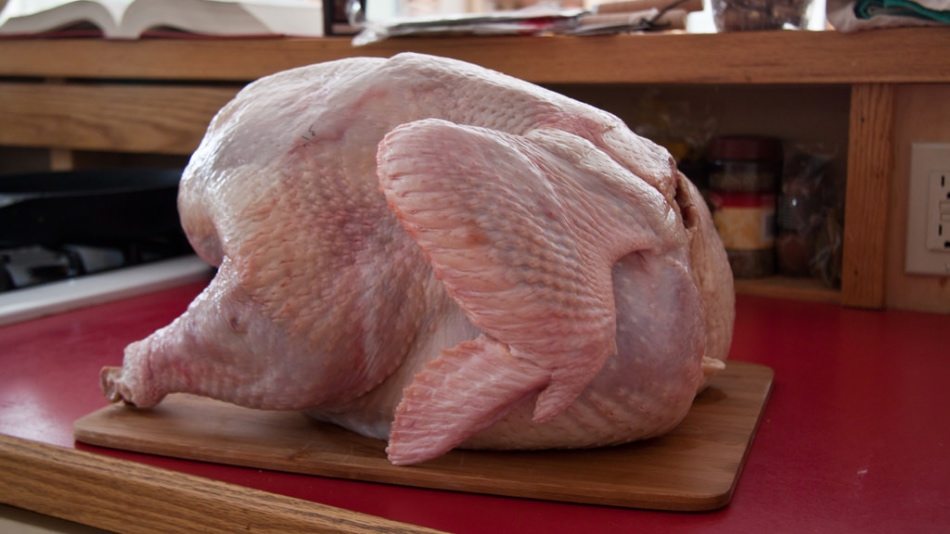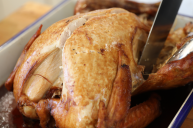I's exciting that there are so many fresh turkey options available these days. Buy one online, put a deposit down on one at a local farm, or order one into a specialty grocery store like Whole Foods. I love the accessibility of fresh turkey, but in the end, I usually buy a frozen turkey for Thanksgiving. When it comes down to it, they're the same in quality but fresh turkeys are more perishable (and more expensive). So here we are again, it's that time of year to remember how to thaw a frozen turkey.
Videos by Wide Open Country
We have a quick-and-dirty guide for turkey thawing times, but we thought we would take the opportunity to give you all the nitty-gritty details here. So let's dive into what you should do (and what not to do) to get that turkey ready for roasting.
1. Do plan to thaw turkey a few days in advance.
Turkeys take anywhere from 2 hours to 6 days, depending on the thawing method and the bird's weight. If you can plan ahead, it's best to thaw turkey in the refrigerator. I always like to have the thawed turkey ready on Wednesday so I can give it a 24-hour brine.
This Thanksgiving turkey thawing chart at FoodSafety.gov will help you know how long to thaw your turkey. If thawing in the refrigerator, follow these guidelines of 24 hours for every 4 to 5 pounds of turkey.
-
4 to 12 pounds: 1 to 3 days
-
12 to 16 pounds: 3 to 4 days
-
16 to 20 pounds: 4 to 5 days
-
20 to 24 pounds: 5 to 6 days
If thawing in cold water, follow these guidelines of approximately 30 minutes per every pound.
-
4 to 12 pounds: 2 to 6 hours
-
12 to 16 pounds: 6 to 8 hours
-
16 to 20 pounds: 8 to 10 hours
-
20 to 24 pounds: 10 to 12 hours
2. Do not thaw turkey at room temperature.
Don't even think about thawing that bird on the kitchen counter at room temperature. Even if you woke up Thanksgiving morning and realize your turkey is still hard as a rock. The countertop creates unsafe temperatures for thawing turkey (known by the USDA as the "danger zone").
This method can lead to bacteria growth in your meat and foodborne illness. No one wants to give everyone food poisoning, so just don't!
3. Do use one of the approved thawing methods.
The Refrigerator Method
This method takes the longest amount of time, but it's so safe that the USDA will allow you to re-freeze the turkey if you'd like. All you need to do is place the turkey in the refrigerator. We recommend you place it in a pan to collect any juices that may escape the packaging.
A good rule of thumb is 24 hours for every 4 to 5 pounds of frozen turkey.
The Cold Water Method
Using the cold water method is a great way to thaw the turkey if you're running short on time. Place the turkey in the sink (or in a large container) and fill it so the turkey is completely submerged. You may have to weigh it down to keep it under the water line.
The only challenge with this method - you have to keep the water under 40 degrees to thaw the turkey safely. That means changing the water every 30 minutes. So keep track of the water temperature with a thermometer, and definitely don't try to use hot water - that is just as bad as thawing the turkey at room temperature!
You need to keep it under cold water for about 30 minutes for each pound of frozen bird.
The Microwave Method
This is our least recommended method. Each microwave oven is different, so it's difficult to recommend hard-and-fast rules. If you have to thaw using the microwave, remove the turkey from its wrapper and place it on a microwave safe dish. Consult your owners manual for power level settings and timings.
4. Do not re-freeze thawed turkey, unless it was thawed in the refrigerator.
Thawed turkey is not safe to re-freeze unless it was thawed in the refrigerator. The USDA cautions that thawing under cold tap water or in the microwave puts the turkey at unsafe temperatures.
It's safe if you're going to cook the turkey immediately after thawing, but it creates a risk if you are re-freezing and cooking at a later time.
5. Do leave the turkey in its original wrapping when thawing, unless using the microwave.
Leaving the turkey in its unopened wrapper keeps the juices inside with the turkey, reducing your risk of cross-contamination with other foods. You should still place the turkey on a tray in the refrigerator, just in case there are small holes in the wrapper.
It's not safe to heat the turkey in its packaging in the microwave, though, so discard that wrapping if you're going for microwave thawing.
6. Do not fret if you forget to thaw your turkey.
Worst case scenario, you forgot to thaw your Thanksgiving turkey. You might not even have time for the quick-thaw in cold water. Never fear, you can cook it frozen! It's not ideal (and it takes twice as long as thawed turkey) but you'll still have something to put on the table. Cook it low and slow at 325 degrees F. Our friends over at the Kitchn created this handy table of cooking times for frozen turkeys:
Estimated Cooking Times for Frozen Turkeys
-
8- to 12-pound turkey: 4 to 4 1/2 hours
-
12- to 14-pound turkey: 4 1/2 to 5 3/4 hours
-
14- to 18-pound turkey: 5 3/4 to 6 1/4 hours
-
18- to 20-pound turkey: 6 1/4 to 6 3/4 hours
-
20- to 24-pound turkey: 6 3/4 to 7 1/2 hours
Partially thawed turkeys will have shorter cooking times
So now that your turkey is thawed, get ready to roast! Check out our guide to everything you need to know about roasting a turkey in the oven.




